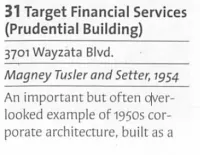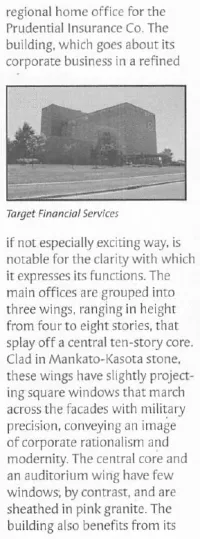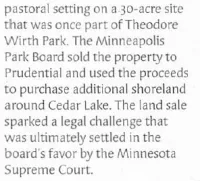Share what you know,
and discover more.
Share what you know,
and discover more.
Jan 01, 2009

-

- Charmaine Bantugan
3701 Wayzata Blvd, Minneapolis, MN, USA
3701 Wayzata Blvd Home History Magney Tusler and Setter, 1954 An important but often over- looked example of 1950s corporate architecture, built as a regional home office for the Prudential Insurance Co. The building, which goes about its corporate business in a refined if not especially exciting way, is notable for the clarity with which it expresses its functions. The main offices are grouped into three wings, ranging in height from four to eight stories, that splay off a central ten-story core. Clad in Mankato-Kasota stone, these wings have slightly projecting square windows that march across the facades with military precision, conveying an image of corporate rationalism and modernity. The central core and an auditorium wing have few windows, by contrast, and are sheathed in pink granite. The building also benefits from its pastoral setting on a 30-acre site that was once part of Theodore Wirth Park. The Minneapolis Park Board sold the property to Prudential and used the proceeds to purchase additional shoreline around Cedar Lake. The land sale sparked a legal challenge that was ultimately settled in the board's favor by the Minnesota Supreme Court. Citation: Millett, Larry. AIA Guide to the Minneapolis Lake District. Minnesota Historical Society Press, 2009.
3701 Wayzata Blvd, Minneapolis, MN, USA
3701 Wayzata Blvd Home History Magney Tusler and Setter, 1954 An important but often over- looked example of 1950s corporate architecture, built as a regional home office for the Prudential Insurance Co. The building, which goes about its corporate business in a refined if not especially exciting way, is notable for the clarity with which it expresses its functions. The main offices are grouped into three wings, ranging in height from four to eight stories, that splay off a central ten-story core. Clad in Mankato-Kasota stone, these wings have slightly projecting square windows that march across the facades with military precision, conveying an image of corporate rationalism and modernity. The central core and an auditorium wing have few windows, by contrast, and are sheathed in pink granite. The building also benefits from its pastoral setting on a 30-acre site that was once part of Theodore Wirth Park. The Minneapolis Park Board sold the property to Prudential and used the proceeds to purchase additional shoreline around Cedar Lake. The land sale sparked a legal challenge that was ultimately settled in the board's favor by the Minnesota Supreme Court. Citation: Millett, Larry. AIA Guide to the Minneapolis Lake District. Minnesota Historical Society Press, 2009.
Jan 01, 2009
3701 Wayzata Blvd, Minneapolis, MN, USA
3701 Wayzata Blvd Home HistoryMagney Tusler and Setter, 1954
An important but often over- looked example of 1950s corporate architecture, built as a regional home office for the Prudential Insurance Co. The building, which goes about its corporate business in a refined if not especially exciting way, is notable for the clarity with which it expresses its functions. The main offices are grouped into three wings, ranging in height from four to eight stories, that splay off a central ten-story core. Clad in Mankato-Kasota stone, these wings have slightly projecting square windows that march across the facades with military precision, conveying an image of corporate rationalism and modernity. The central core and an auditorium wing have few windows, by contrast, and are sheathed in pink granite. The building also benefits from its pastoral setting on a 30-acre site that was once part of Theodore Wirth Park. The Minneapolis Park Board sold the property to Prudential and used the proceeds to purchase additional shoreline around Cedar Lake. The land sale sparked a legal challenge that was ultimately settled in the board's favor by the Minnesota Supreme Court.
Citation: Millett, Larry. AIA Guide to the Minneapolis Lake District. Minnesota Historical Society Press, 2009.
Posted Date
Sep 25, 2023
Historical Record Date
Jan 01, 2009
Source Name
AIA Guide to the Minneapolis Lake District
Delete Story
Are you sure you want to delete this story?













